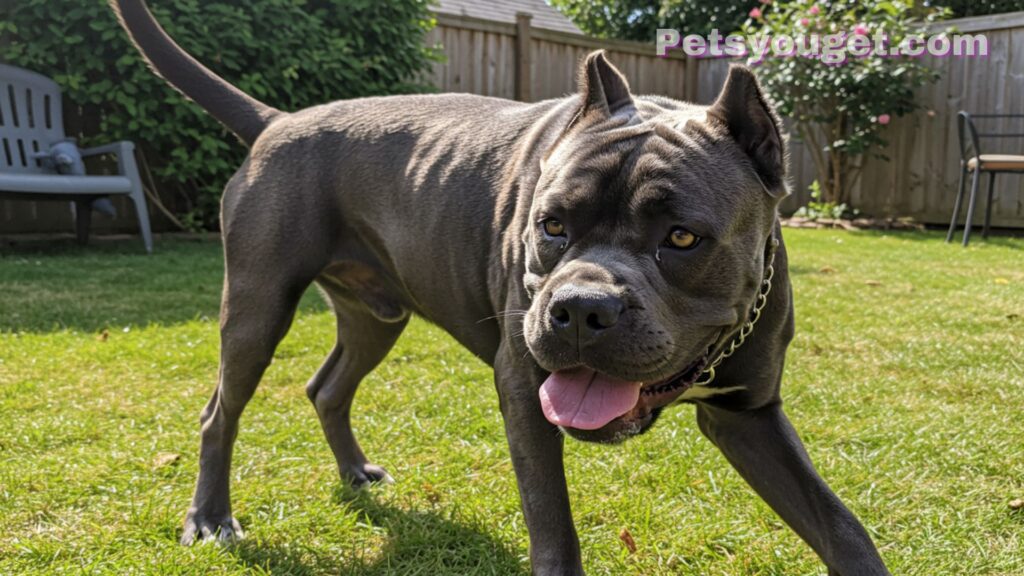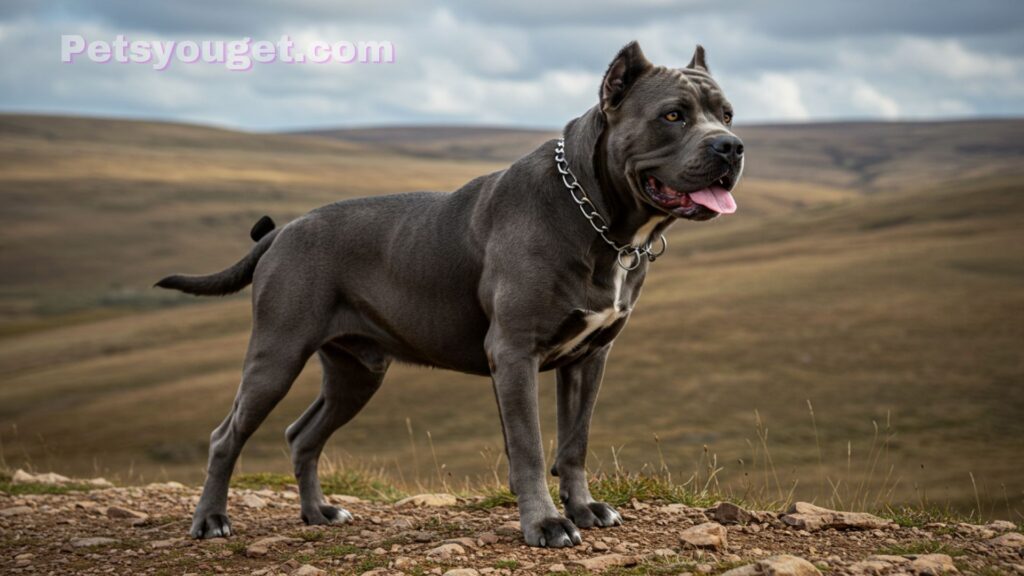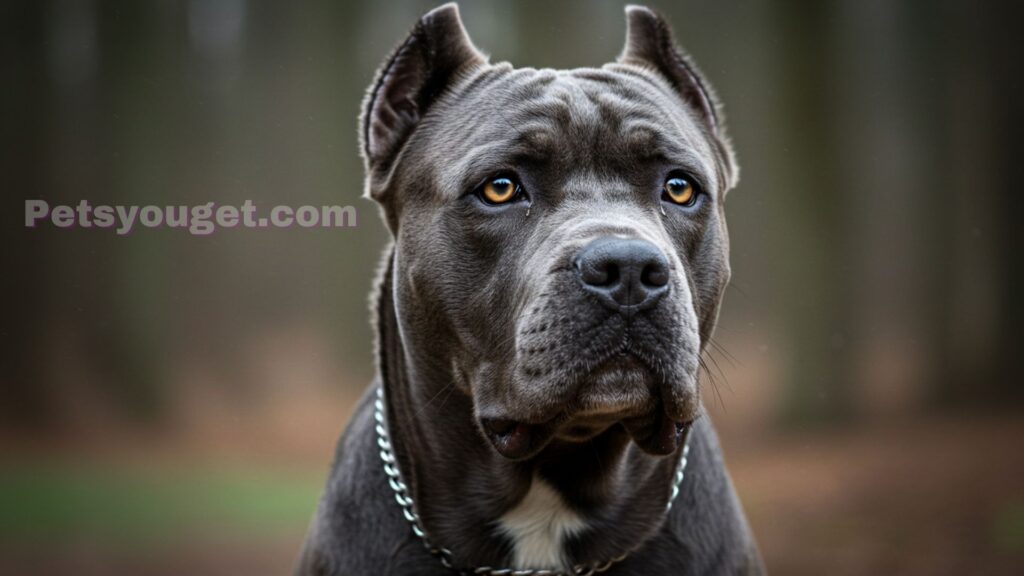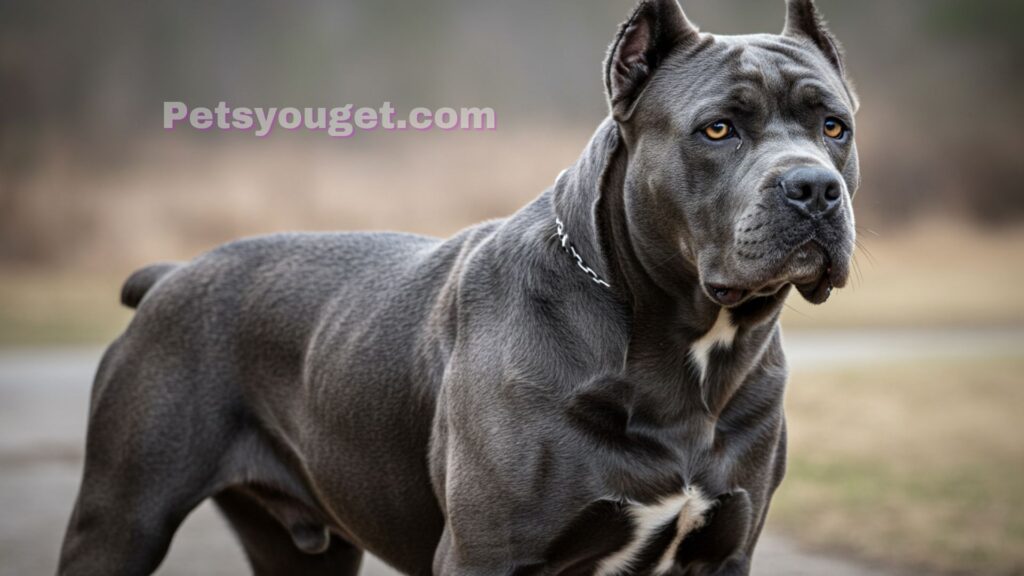The Blue Cane Corso is an Italian mastiff with a unique personality that makes it stand out among the sought-after breeds. Known for its power, it has a willful disposition and is often praised for its guardian instincts. This breed, with its distinct coat colors including shades of gray and black, is rapidly gaining in popularity, particularly in recent years. With its impressive size and strength, it makes for a loyal companion dog and a fearless protector, stemming from its history as war dogs and large game hunters. The Cane Corso has made a notable comeback as a favorite in many homes due to its intelligence and protective nature.

The breed’s origin in Italy is marked by its dual role: it’s not only a guardian but also used for farm animal herders and, more recently, has become a popular family dog. With its loyal temperament, this breed is highly valued as a companion dog and continues to be a popular choice for those looking for an active, strong, and affectionate pet. While the Blue Cane Corso can be a bit intimidating due to its strength and size, it’s an awesome breed with the right training and socialization, making it a fantastic fit for experienced dog owners.
Breed Overview
The Cane Corso has a fascinating lineage dating back to ancient Rome, where it was bred for various purposes, including as a working dog and protector. It shares genes with the Greek Molossus, an ancient canine breed known for its muscular and imposing stature. The Blue Cane Corso dog, with its intimidating disposition, is one of the most remarkable variations, showcasing strength and confidence. This breed has survived throughout history, though some of its ancient relatives became extinct. Today, the Cane Corso remains a popular choice for those seeking a loyal, active companion.
An athletic breed, the Blue Cane Corso requires an attentive owner who can provide proper socialization and training. While it has a varied range of characteristics, it’s known for its confident nature and strong presence. However, owning one is not recommended for a novice dog owner, as they need an experienced handler who can set aside time for consistent training and exercise. This breed is not only active but also requires a strong, focused disposition to be well-behaved and harmonious with family members.
Blue Blood Cane Corso Breed Appearance
The Blue Blood Cane Corso is known for its distinctive appearance that fits the breed standard. This large, muscular, and powerful dog makes an imposing presence wherever it stands. Typically, they stand between 23 to 28 inches tall at the shoulder, and can weigh anywhere from 90 to 120 pounds, showcasing their robust size. The head of the Blue Cane Corso is broad and square, with a strong muzzle and large jaws, which are essential for their original role as guardians and protectors. Their eyes are almond-shaped, further enhancing their striking expression.
Their ears are set high, and many owners choose to have them cropped, maintaining a more traditional appearance. The coat of the Blue Blood Cane Corso is one of its most notable features, with a blue-gray coat that adds to its unique and striking appearance. While their coat color can also range from black, fawn, gray, to brindle, the blue-gray is the most sought-after, making this breed an attention-grabber wherever it goes. Whether for a guard dog or a companion, the Blue Blood Cane Corso has a powerful and eye-catching presence that is hard to miss.
Unraveling the Unique Characteristics of Blue Cane Corsos

The Blue Cane Corso stands out from its Cane Corso counterparts due to a few key differences in both its color variation and distinct appearance. One of the most captivating coat colors is the blue-gray coat, which is short, dense, and even water-resistant, making it suitable for protection in harsh weather conditions. While their muscular and powerful build reflects their athletic nature, the broad heads, strong jaws, and almond-shaped eyes give them a striking and impressive appearance. However, they are prone to certain skin issues, requiring proper care and regular grooming to maintain their health and keep their coat in top condition.
When it comes to personality, the Blue Cane Corso possesses a mix of intelligence, loyalty, and protective instincts, which makes them excellent watchdogs. They are known for being affectionate with their family members but exhibit a wariness toward strangers, a trait often tied to their history as war dogs. While they may appear intimidating, their temperament can be molded with proper training and socialization, turning them into gentle giants that are adaptable to different living situations.
The Earliest Records of the Blue Cane Corso in History
The history of the Blue Cane Corso can be traced back to the Greek Islands and the time of the Romans, where they were related to the ancient Molossus dogs. These canines were known for their strength and agility, and their descendants helped shape the native Italian breeds we recognize today, such as the Neapolitan Mastiff and the Cane Corso. These dogs played significant roles in the Macedonian wars, as well as in the Roman Empire, where they were used as war dogs, often stationed at the periferi of the battlefield or deployed to disrupt enemy lines with tactics like carrying flaming oil.
Over time, their duties expanded to guarding homes, livestock, and even participating in hunting wild game like boars, porcupines, and badgers. These versatile farmhands and guards were essential to the farming practices on the Italian Peninsula, particularly in areas like Mantova, where they were selectively bred to meet specific needs. The name Corsi became synonymous with these dogs, known for their boar hunters, badger flushers, and more, as their breed numbers rose and fell through the centuries.
By the 19th century, the breed began to suffer due to political and social upheaval, and their numbers dwindled, especially after the world wars. However, in the 1970s, breed enthusiasts and dedicated breeders, such as the Malavasi brothers, revived the breed and worked towards creating a breed standard. This effort led to the return of the Blue Cane Corsos, selectively bred for their impressive traits and distinctive blue-gray coats, marking a triumphant comeback for this iconic breed.
How the Blue Cane Corso Gained Popularity
The Blue Cane Corso experienced a remarkable rise in popularity thanks to Michael Sottile, a Neapolitan Mastiff aficionado who was instrumental in the breed’s rediscovery in 1988. While visiting Sicily to see a farmer who used the Cane Corso for herding cows, Sottile encountered what was thought to be an almost-extinct dog. Struck by its impressive traits and the dog’s role as both a protector and a family pet, he set out to revive the breed. His efforts included promoting the Blue Cane Corso as a versatile and loyal companion, ultimately helping them gain a spot as beloved guardians.
By 2021, the Cane Corso had surged in popularity, ranking among the most popular dog breeds in the US. Their loyalty, confidence, and intelligence quickly made them favorite pets for families seeking an active and protective dog. With their growing sociability and impressive stature, the Blue Cane Corso became a symbol of strength, reliability, and elegance, capturing the hearts of dog owners across Europe and the US.
Formal Recognition of the Blue Cane Corso

The journey towards formal recognition of the Blue Cane Corso began with the efforts of Corso enthusiasts and the Società Amatori Cane Corso, founded in 1983. However, despite the growing interest in the breed, there was a decline in popularity in the years following. As part of a larger effort to preserve the breed, the Blue Cane Corso was initially recognized on a provisional basis by the Ente Nazionale della Cinofilia Italiana (ENCI) in 1994, which marked a crucial step in its resurgence.
By 2007, the Cane Corso gained full recognition from the World Canine Organization (FCI), which provided global validation. In 2008, the breed reached another milestone when it was formally accepted by the United Kennel Club (UKC). The breed continued to gain widespread recognition, and in 2010, the American Kennel Club (AKC) officially acknowledged the Blue Cane Corso, solidifying its place in the world of ancient breeds and marking its status as a cherished and officially recognized breed across the globe.
A Showcase of the Blue Cane Corso’s Abilities
The Blue Cane Corso is a capable and versatile breed, historically used in protection, hunting, and even war. Their impressive physical strength and intelligence make them skilled working dogs that excel in various activities. From obedience training to agility, they are eager to please and thrive in working roles such as search and rescue, police, and military work. Their loyalty and natural protective instincts also make them ideal for therapy work and as service dogs.
As loyal companions, Blue Cane Corsos are also known for their gentle nature with children and their role as excellent companions for families. Their versatility makes them perfect for families looking for a gentle yet protective dog, fulfilling the breed’s requirements while maintaining their status as loyal companions. Whether in working roles or as family pets, the Blue Cane Corso is a breed that brings dedication and love to every task.
Key Points:
- The Blue Cane Corso is skilled in protection, hunting, and war due to their physical strength and intelligence.
- They excel in obedience training, agility, and various working roles like police or military work.
- They are gentle and protective, making them excellent family pets and companions for children.
Blue Blood Cane Corso Health
The Blue Blood Cane Corso is generally a healthy breed, but like any dog, it can face specific health issues. Responsible breeding practices and regular veterinary check-ups are crucial to maintaining their well-being. Regular preventive care helps ensure they remain active and strong. However, there are some health concerns that may affect them due to their genetic makeup and size.
Hip Dysplasia and Elbow Dysplasia
These genetic conditions impact the joints, leading to pain and reduced mobility. They occur when the hip or elbow joint does not develop properly, causing wear and tear over time. Maintaining a healthy weight and providing moderate exercise can help minimize discomfort, along with early veterinary intervention.
Bloat (Gastric Torsion)
A life-threatening condition, bloat happens when the stomach fills with gas and twists, leading to pressure on internal organs. This can occur suddenly, especially after eating large meals or engaging in vigorous exercise. Feeding smaller, frequent meals and avoiding exercise immediately after eating can reduce the risk.
Dilated Cardiomyopathy (DCM)
This heart condition weakens the heart muscle, making it harder to pump blood effectively. It can lead to fatigue, coughing, or even sudden collapse. Regular heart screenings by a vet and a healthy lifestyle can help detect and manage this issue early.
Skin Conditions (Demodectic Mange and Allergies)
Due to their blue-gray coat, the Blue Blood Cane Corso is prone to skin issues like demodectic mange, which is caused by mites, and allergies, which can cause irritation and hair loss. Regular grooming, proper diet, and skin checks are essential for keeping their coat and skin in good condition.
Blue Blood Cane Corso Breed Maintenance

Keeping the Blue Blood Cane Corso in top condition involves regular care for their health and well-being. With their short, dense coat, this breed requires minimal grooming, but consistent attention is key to maintaining their overall quality of life. Below are three important maintenance tasks for this impressive breed:
- Grooming and Coat Care
The Blue Blood Cane Corso has a short coat that benefits from regular brushing to remove loose hair and keep their skin healthy. Bathing should be done occasionally or when they get dirty, as their coat naturally repels dirt. Additionally, check and clean their ears regularly to prevent infections. - Exercise and Physical Activity
With a high activity level, these dogs thrive on daily physical activities like walking, running, or interactive play. Regular exercise not only maintains their health but also supports their mental well-being. Avoid overexertion, especially after meals, to reduce the risk of bloat. - Diet and Dental Care
A well-balanced diet tailored to their age, stature, and energy needs is essential. Feeding smaller, frequent meals can help prevent bloat. For dental health, brushing their teeth two to three times a week prevents tartar buildup and reduces the risk of gum disease.
By following these steps, the Blue Blood Cane Corso can live a healthy, happy life.
Blue Blood Cane Corso Temperament
The Blue Blood Cane Corso is known for its intelligent and loyal nature, making it a highly protective companion for families. This breed forms strong bonds with its loved ones, showing an affectionate side that fosters trust within the household. While naturally wary of strangers, they excel as watchdogs, offering both security and companionship. Early socialization is vital to help them grow into well-rounded dogs who are comfortable in various environments and around other people and animals.
Although confident, the Blue Blood Cane Corso requires consistent training to avoid aggressive or fearful behaviors. They are strong-willed but also eager to please, responding best to positive reinforcement and structured training methods. These powerful dogs thrive under the guidance of experienced dog owners who can provide the right guidance and structure.
With the right care, the Blue Blood Cane Corso becomes a remarkable and balanced member of any family, showcasing its exceptional temperament while remaining a powerful and reliable breed.
Blue Cane Corso Physical and Mental Activity Requirements
The Blue Cane Corso is an energetic and athletic breed that thrives with regular exercise to maintain its physical health and mental health. A daily walk, jog, or playtime in a securely fenced area keeps them active and happy. These powerful dogs excel in dog sports like obedience, agility, and tracking, which combine physical activity with mental stimulation. Incorporating activities like a flirt pole or interactive games not only meets their exercise needs but also strengthens their bond with their owner.
To prevent boredom and avoid destructive behaviors, it’s essential to engage the Blue Cane Corso with puzzle toys, training sessions, and tasks that keep their minds sharp and focused. Their loyal and loving nature makes them eager to please, so these activities also reinforce positive behavior while fulfilling their mental stimulation needs.
With the right care and attention, this remarkable breed becomes a devoted companion, ensuring both their physical and mental health are nurtured for many years of happiness.
Top 7 Unique Facts about Blue Cane Corsos
1. Blue Cane Corso Are Black
The Blue Cane Corso may appear gray, but its unique coat comes from a recessive dilute gene that affects eumelanin, the pigment responsible for black coloring. While many think of it as a black dog, the coat often exhibits graying shades, giving it a striking look. This rare trait is achieved through careful selective breeding within the breed, making the black Cane Corso with this distinct hue a prized variation.
2. The Breed Has Varying Eye Colors
The Blue Cane Corso is often born with dark blue eyes that evolve into varying shades as they grow. These can range from amber, gold, to rich brown, with some even showcasing light amber tones. The striking appearance of their eyes beautifully contrasts with their gray coat, making them look exceptionally unique and captivating.
3. The Blue Cane Corso Requires a Firm Leader
The Blue Cane Corso is an intelligent breed that requires constant and consistent training throughout its life. With its willful nature and massive, powerful frame, it also has an independent streak, which makes a confident and firm leader absolutely required to guide it. While this breed is eager to please, setting clear expectations is essential for a well-behaved companion.
4. Blue Cane Corsos Aren’t Lazy Couch Potato Dogs
The Cane Corso is a hardworking breed that thrives when it has a job to do. Unlike typical couch potatoes, this working dog excels at tasks, needing both physical stimulation and mental stimulation to stay happy. While they can be snuggly and enjoy a good rest after a hard day’s work, they don’t simply sleep the day away. To exist happily, they require active engagement and attention.
5. Cane Corsos Have Several Recognized Breed Colors
The Cane Corso, as recognized by the American Kennel Club (AKC), has a wide variety of coat colors that make this breed stand out. From blue to black and gray, there are many hues and color variations that adhere to breed standards. These dogs can also have brindled or fawn coats, with subtle color differences like dusty brown, cream, or light tan. Some even sport masks, with chestnut or blue patterns, adding to their beauty and unique appearance.
6. Cane Corsos Have a Ferocious Bite
The Blue Cane Corso is not naturally aggressive but has an incredible bite force that is quite impressive. Measured at 525 to 700 pounds per square inch (PSI), this force is much stronger than the average human bite force, which is only 140 PSI. These dogs, weighing around 100 pounds, are formidable guard dogs due to their powerful bite. However, in comparison, the Cane Corso’s bite is outdone by other breeds like the American Bandogge with 730 PSI and the Kangal at 734 PSI, yet the Cane Corso remains a formidable and peaceful canine overall.
7. Blue Cane Corsos Are Vocal Dogs
The Cane Corso, especially the Blue Cane Corso, is known for being quite vocal. These dogs are frequent barkers, making various vocalizations and noises. Along with barking, they might also engage in snorting, snuffing, and even howling or singing. This is part of their natural behavior, and the AKC recognizes that these dogs express themselves through a range of sounds. If you’re looking for a quiet dog, a Blue Cane Corso may not be the best choice due to their vocal nature.
Does the Blue Cane Corso Make a Good Pet?

The Blue Cane Corso can be an excellent pet for the right owner, especially if you are prepared for its large and powerful presence. These dogs are known to be vigilant, fearless, and protective, making them great companions for families with older children. They are loyal and can be very affectionate once properly socialized. However, their massive strength and protective nature mean they require consistent training to ensure they are well-behaved around people, other pets, and even strangers.
While they may seem aloof at first, especially towards unfamiliar faces, Blue Cane Corsos are also known for their goofy and sometimes attention-seeking behavior. They can produce weird vocals such as snoring or snuffing, which can be a bit odd for some owners, but these sounds are part of their unique charm. They are a social breed that enjoys being part of the family, but it’s important to note that their double-layered short coat sheds, especially in springtime.
Owning a Blue Cane Corso comes with responsibilities, as they are prone to certain genetic conditions. They can live up to 10-12 years, and it is essential to keep them healthy with proper care. Their heavier jowls and tendency to slobber are worth considering, as well as their need for firm and consistent training. With the right guidance, they make great family dogs, but their powerful nature means they need full control from their owner.
Tips for Keeping Your Cane Corso Dog Healthy, Safe, and Happy
To keep your Blue Cane Corso healthy and happy, it’s important to meet their basic grooming needs and ensure they get regular exercise. This breed has a lot of energy and loves outdoor activities, so giving them ample time to run and play is key for their well-being. Since Blue Cane Corsos are strong and active, a sturdy fence is necessary to keep them safe and prevent them from running off. Their instinct for chasing can be strong, and without proper training, they may pose a risk to small pets or animals. Additionally, it’s crucial to avoid inbreeding, which can lead to genetic conditions like hip dysplasia, gastric dilatation-volvulus, and ectropion.
Feeding your Blue Cane Corso the right amount of food is vital for their overall health. Typically, they need about 4 to 5 cups of dry food or kibble, divided into two daily meals for proper digestion. Along with consistent training and regular physical activity, these habits will ensure your Cane Corso remains balanced, healthy, and happy.
Final Thoughts on the Blue Cane Corso
The Blue Cane Corso is a powerfully built dog with a willful disposition. With its stunning blue coat hues that can vary in shades of gray and black, this breed makes a remarkable companion. However, due to their ferocious instinct and history as war dogs, they may not be suited for every dog owner. They require a strong, firm direction in training to ensure they become well-behaved, making them ideal as working dogs or guard dogs. Their loyalty and protective nature make them excellent companions, but they do best with owners who understand their needs and are prepared to provide the proper care and discipline.
FAQs
What is the ideal diet for a Blue Cane Corso?
To keep your Blue Cane Corso healthy, they should be fed 4 to 5 cups of dry food or kibble, divided into two daily meals. This ensures proper digestion and helps maintain their health.
How much exercise does a Blue Cane Corso need?
Blue Cane Corsos are active dogs with a lot of drive. They require regular exercise and enjoy outdoor activities like running and playing. Giving them plenty of space to exercise is important for their well-being.
Do Blue Cane Corsos need a sturdy fence?
Yes, Blue Cane Corsos are strong and active dogs that require a sturdy fence. Their natural instinct for chasing can lead them to run off if not properly contained. A secure fence will help keep them safe.
What genetic conditions are common in Blue Cane Corsos?
Genetic conditions like hip dysplasia, gastric dilatation-volvulus, and ectropion can affect Blue Cane Corsos, especially if inbreeding occurs. Proper care and avoiding inbreeding can reduce these risks.
Are Blue Cane Corsos good with small pets?
Without proper training, Blue Cane Corsos can be a danger to small pets due to their strong chasing instincts. However, with consistent training and socialization, they can coexist peacefully with other animals.



